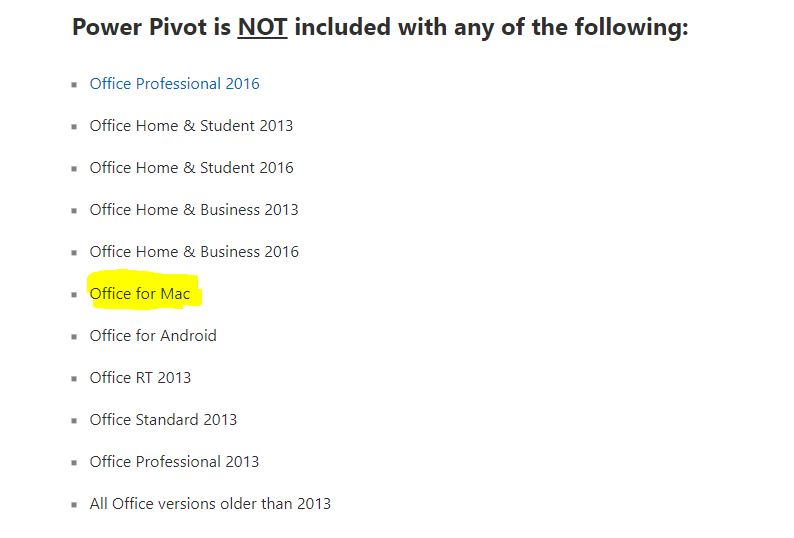Important notes:
For BOTH Office 2013, Office 2016, the “Data Model” is actually built into the Excel fabric, itself. So any edition of Office 2013/2016 can interact with a PowerPivot Excel Workbook (open it, click on slicers, change the pivot table etc.). Only when you attempt to “author” the Model – would you need the correct version of Office. PowerPivot for Excel can be installed on a computer that has 32-bit or 64-bit Excel 2010. If you have installed the 32-bit version of Excel, you must install the 32-bit version of PowerPivot for Excel. Likewise, if you have installed the 64-bit version of Excel, you must install the 64-bit version of PowerPivot for Excel.
Power Query and Power Pivot are available only on Microsoft Office suites meant for businesses (i.e. Professional/ Enterprise) or certain standalone Excel versions.
MS Suites and OS that do not support these add-ins: Mac, Microsoft Office Home/Home & Student.
To not miss out on the fun, Mac users are encouraged to install Boot Camp or Virtual Machine to gain access to a Windows platform on your Mac.
How to install Power Query
This depends on which version of Excel you have. If it is Excel 2016, you do not need to do anything. Power Query has already been integrated into the main workbook platform. It sits under the “Data” Tab and is covered under “Get & Transform Data” and “Queries & Connections” sections.
If you have a different version of Excel, head over to Microsoft's website to check if your version supports the Power Query plug-in and download the installation file.
(Unsure if your Excel version is running on 32-bit or 64-bit? Click on the video below for instructions.)
Once the installation file is downloaded, open up the file and follow the steps in the Setup Wizard window. When you have been prompted that installation is complete, open Excel and you show see a Power Query tab on your toolbar.
If for any reason, your Power Query tab vanishes after the installation, just follow the same steps below to get it back.
Note: Both Power Query and Power Pivot sit under COM Add-ins in Excel, so those are the same steps you want to follow.
How to install Power Pivot
If you are using Excel 2013 and 2016, simply follow the steps below:
Step 2: Select Add-ins > Manage > COM Add-ins > Go..
Once the window opens, select the Add-ins option on the left-hand side column. Go to the bottom of the loaded page and click on the Manage drop-down list. Choose COM Add-ins from the list and hit on the “Go…” button Pirets of the caribbean3movei hindi dubbed filmy zilla. right next to it.
Step 3: Select Microsoft Power Pivot for Excel and press OK
A separate window should pop-up after you hit the “Go…” button. Select “Microsoft Power Pivot for Excel” and press the “OK” button.
Now, you should see an additional tab appear on your Excel window with the words “Power Pivot”.
If you are using a different version of Excel, head over to Microsoft website to check if your version supports the Power Pivot plug-in and download the installation file.
Once the installation file is downloaded, follow the steps above to get access to the Power Pivot plug-in. Alternatively, you can view the video below for more visual instructions.
To check if your Excel version supports Power Query and Power Pivot and download the installation files, click on the below links:Power Query: https://www.microsoft.com/en-us/download/details.aspx?id=39379
Power Pivot: https://support.office.com/en-us/article/Where-is-Power-Pivot-aa64e217-4b6e-410b-8337-20b87e1c2a4b
','raw':false},'hSize':null,'floatDir':null,'customThumb':'5b252900575d1f6f792a5164','html':'','url':'https://youtu.be/o6FcAd-GGkc','thumbnailUrl':'https://i.ytimg.com/vi/o6FcAd-GGkc/hqdefault.jpg','resolvedBy':'youtube'}'>'>
Note
A to z civil engineering book by mantri pdf. Office 365 ProPlus is being renamed to Microsoft 365 Apps for enterprise. For more information about this change, read this blog post.
Symptoms
In Microsoft Excel, when attempting to use controls on the PowerPivot ribbon, you find that the controls are grayed out, as in the following figure.
The behavior may appear to be inconsistent between existing files; however, it occurs in any new file you attempt to create in Excel.
Excel Powerpivot Para Mac Online
Cause
This behavior can occur if the Save files in this format option is set to a file format other than the default Excel Workbook, as in the figure below.
Here are some of the formats which may result in this behavior:
- XML Spreadsheet 2003
- Strict Open XML Spreadsheet
- OpenDocument Spreadsheet
The availability of PowerPivot controls is specific to the file type of the active document, depending on whether that file type supports the PowerPivot features.
New, unsaved documents will enable or disable the PowerPivot controls based on the current Save files in this format option setting. If the file is later saved as a file type that supports PowerPivot, the controls on the PowerPivot ribbon will then be enabled.

Resolution
To allow the use of the PowerPivot ribbon controls in new documents, configure the Save files in this format option to the default setting of Excel Workbook, using the steps below.
- From the File tab in Excel, select Options.
- In the Excel Options dialog, select Save.
- In the Save Workbooks section, select Excel Workbook from the Save files in this format dropdown.
If you are currently working in a file that is not the default format, you may need to Save As an Excel Workbook, or open a new workbook before the PowerPivot ribbon controls become available.
More Information
Excel Powerpivot Para Mac Y
The setting for the default Save format is stored in the Windows Registry under the following registry data:
Excel Powerpivot Para Mac En
Key: HKEY_CURRENT_USERSoftwareMicrosoftExcel15.0Options
DWORD: DefaultFormat
Example values:
33 (51) = Excel Workbook (Excel standard default)
2e (46) = XML Spreadsheet 2003
3d (61) = Strict open XML spreadsheet
3c (60) = OpenDocument spreadsheet